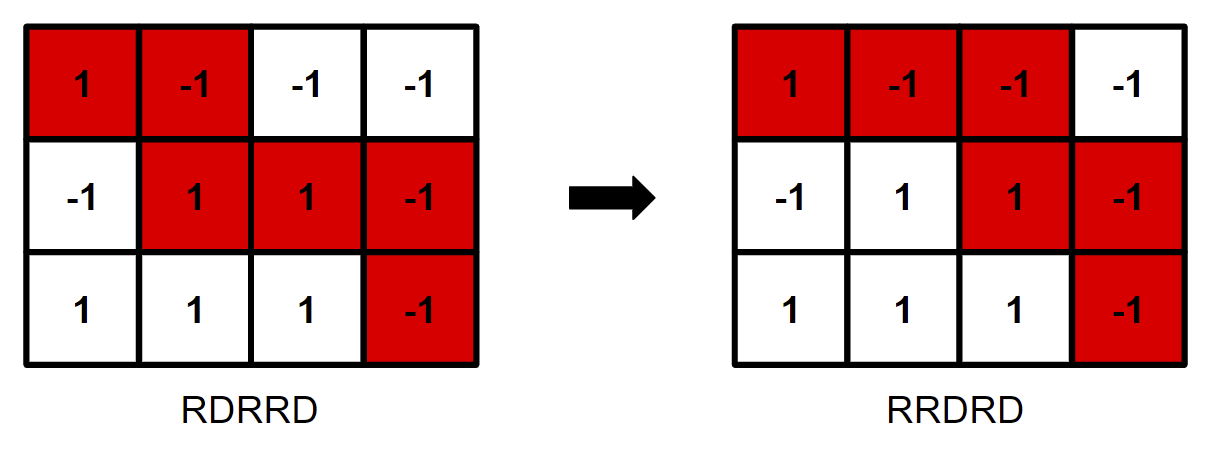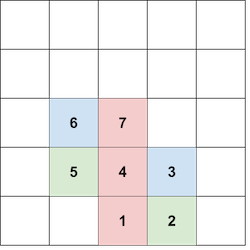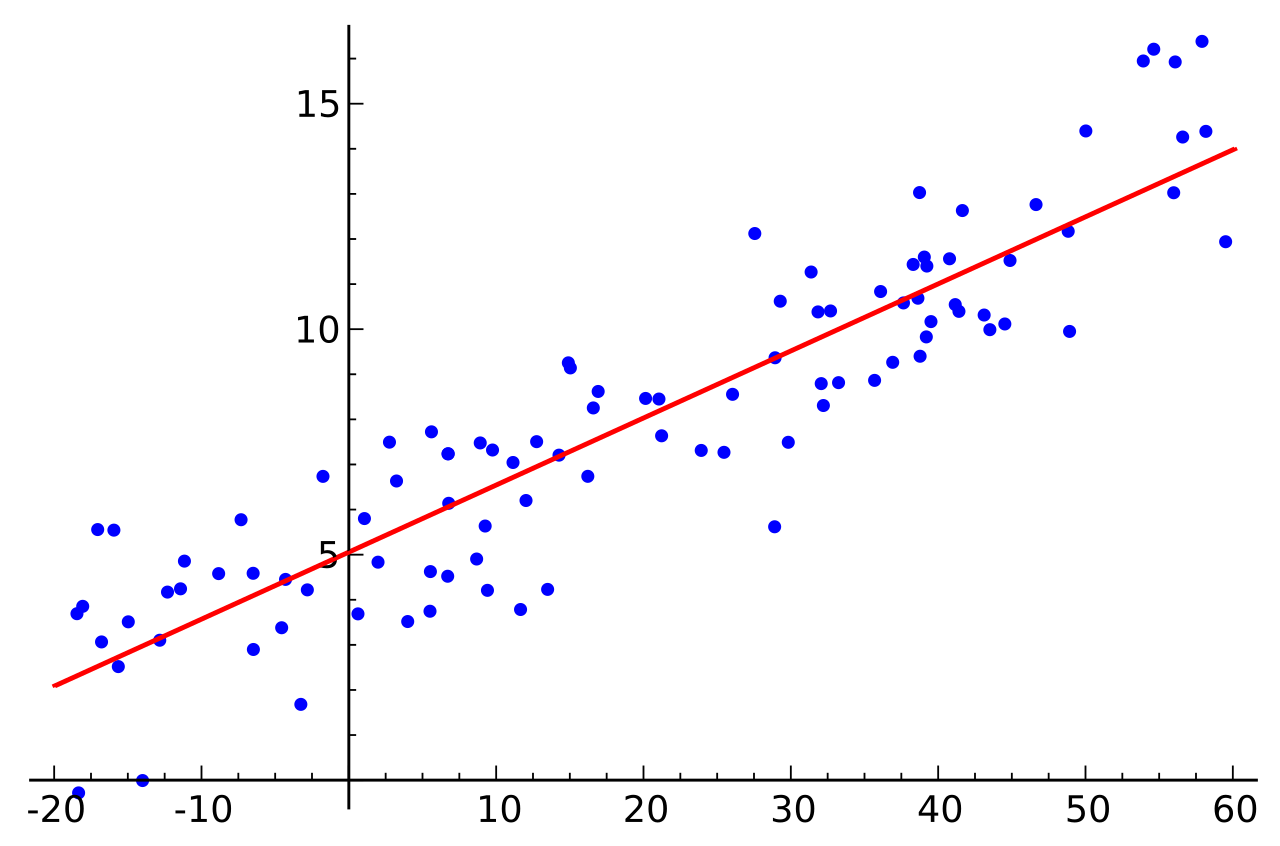题目链接(CF ,洛谷) | 强烈推荐博客 中观看。
这题是真的难想,我 cf 的题解看了好久才搞明白(我太菜了)。
题意
给你一个长度为 n n n a a a b b b a a a
如果对于所有区间 [ l , r ] ( 1 ≤ l ≤ r ≤ n ) [l, r] (1 \le l \le r \le n) [ l , r ] ( 1 ≤ l ≤ r ≤ n )
MEX ( a l , a l + 1 , … , a r ) = MEX ( b l , b l + 1 , … , b r ) \operatorname{MEX}(a_l, a_{l + 1}, \ldots , a_r) = \operatorname{MEX}(b_l, b_{l + 1}, \ldots , b_r)
MEX ( a l , a l + 1 , … , a r ) = MEX ( b l , b l + 1 , … , b r )
我们就称排列 a a a b b b
其中 MEX \operatorname{MEX} MEX c c c c c c x x x
例如 MEX ( [ 1 , 2 , 3 , 4 , 5 ] ) = 0 MEX ( [ 0 , 1 , 2 , 4 , 5 ] ) = 3 \operatorname{MEX}([1,2,3,4,5]) = 0 \ \operatorname{MEX}([0,1,2,4,5]) = 3 MEX ([ 1 , 2 , 3 , 4 , 5 ]) = 0 MEX ([ 0 , 1 , 2 , 4 , 5 ]) = 3
由于答案可能会很大,所以输出时需要打印答案模 1 0 9 + 7 10^9 + 7 1 0 9 + 7
思路
直接想答案可能比较难,可以先模拟一下给出的样例,尝试构造出一些 b b b
a = [ 1 , 3 , 7 , 2 , 5 , 0 , 6 , 4 ] a = [1, 3, 7, 2, 5, 0, 6, 4] a = [ 1 , 3 , 7 , 2 , 5 , 0 , 6 , 4 ]
我们从 0 0 0 b b b 0 0 0 a a a 0 0 0
为什么呢?我们定义在 a a a 数字 i i i pos i \text{pos}_i pos i pos 0 = 6 \text{pos}_0 = 6 pos 0 = 6 1 1 1
这时,选择 [ pos 0 , pos 0 ] [\text{pos}_0, \text{pos}_0] [ pos 0 , pos 0 ] a a a b b b MEX \operatorname{MEX} MEX a a a a [ pos 0 ] = 0 a[\text{pos}_0] = 0 a [ pos 0 ] = 0 a a a MEX ( [ pos 0 ] ) \operatorname{MEX}([\text{pos}_0]) MEX ([ pos 0 ]) 1 1 1
如果 b b b 0 0 0 b b b a [ pos 0 ] > 0 a[\text{pos}_0] > 0 a [ pos 0 ] > 0 MEX ( [ pos 0 ] ) \operatorname{MEX}([\text{pos}_0]) MEX ([ pos 0 ]) 0 0 0
所以我们可以推断出 0 0 0
我们还能推出,1 1 1
可以考虑 [ pos 1 ( 1 ) , pos 0 ( 6 ) ] ( 1 3 7 2 5 0 ) [\text{pos}_1(1), \text{pos}_0(6)] (1\ 3\ 7\ 2\ 5\ 0) [ pos 1 ( 1 ) , pos 0 ( 6 )] ( 1 3 7 2 5 0 ) [ pos 1 + 1 , pos 0 ] ( 3 7 2 5 0 ) [\text{pos}_1 + 1, \text{pos}_0](3\ 7\ 2\ 5\ 0) [ pos 1 + 1 , pos 0 ] ( 3 7 2 5 0 ) MEX \operatorname{MEX} MEX
因为 1 1 1 MEX ( [ pos 1 , pos 0 ] ) \operatorname{MEX}([\text{pos}_1, \text{pos}_0]) MEX ([ pos 1 , pos 0 ]) 1 1 1 0 0 0 1 1 1 MEX ( [ pos 1 + 1 , pos 0 ] ) \operatorname{MEX}([\text{pos}_1 + 1, \text{pos}_0]) MEX ([ pos 1 + 1 , pos 0 ]) 1 1 1
架设我们在 b b b 1 1 1 2 2 2 b b b MEX ( [ pos 1 + 1 , pos 0 ] ( 1 7 2 5 0 ) ) \operatorname{MEX}([\text{pos}_1 + 1, \text{pos}_0](1\ 7\ 2\ 5\ 0)) MEX ([ pos 1 + 1 , pos 0 ] ( 1 7 2 5 0 )) 1 1 1 a a a 1 1 1
现在考虑能合法放置 2 2 2 a a a 2 ∈ ( pos 1 , pos 0 ) 2 \in (\text{pos}_1, \text{pos}_0) 2 ∈ ( pos 1 , pos 0 ) b b b 2 2 2 ( pos 1 , pos 0 ) (\text{pos}_1, \text{pos}_0) ( pos 1 , pos 0 )
为啥呢?我们设区间 [ l , r ] [l, r] [ l , r ] a a a 0 0 0 1 1 1 l ≤ pos 1 , pos 0 ≤ r l \le \text{pos}_1, \text{pos}_0 \le r l ≤ pos 1 , pos 0 ≤ r
那因为在 a a a 2 ∈ ( pos 1 , pos 0 ) 2 \in (\text{pos}_1, \text{pos}_0) 2 ∈ ( pos 1 , pos 0 ) [ l , r ] [l, r] [ l , r ] MEX \operatorname{MEX} MEX 2 2 2 a a a 0 0 0 1 1 1 2 2 2
同时,在 a a a l ≤ pos 1 , pos 0 ≤ r l \le \text{pos}_1, \text{pos}_0 \le r l ≤ pos 1 , pos 0 ≤ r MEX \operatorname{MEX} MEX 1 1 1 0 0 0 MEX \operatorname{MEX} MEX 1 1 1
那么在 b b b 2 ∈ ( pos 1 , pos 0 ) 2 \in (\text{pos}_1, \text{pos}_0) 2 ∈ ( pos 1 , pos 0 ) MEX ( [ l , r ] ) > 2 \operatorname{MEX}([l, r]) > 2 MEX ([ l , r ]) > 2 a a a b b b
符合这样的位置一共有 ( pos 0 − pos 1 + 1 ) − 2 (\text{pos}_0 - \text{pos}_1 + 1) - 2 ( pos 0 − pos 1 + 1 ) − 2 − 2 -2 − 2 0 0 0 1 1 1
那么如果在 a a a 2 ∉ ( pos 1 , pos 0 ) 2 \notin (\text{pos}_1, \text{pos}_0) 2 ∈ / ( pos 1 , pos 0 )
比如 a = [ 1 , 3 , 7 , 6 , 0 , 5 , 2 , 4 ] a = [1, 3, 7, 6, 0, 5, 2, 4] a = [ 1 , 3 , 7 , 6 , 0 , 5 , 2 , 4 ]
我们可以推断出,和前面讲的 0 0 0 1 1 1 b b b 2 2 2
考虑 [ pos 1 , pos 2 ] [\text{pos}_1, \text{pos}_2] [ pos 1 , pos 2 ] MEX \operatorname{MEX} MEX 2 2 2 [ pos 1 , pos 2 − 1 ] [\text{pos}_1, \text{pos}_2 - 1] [ pos 1 , pos 2 − 1 ] MEX \operatorname{MEX} MEX 2 2 2 0 0 0 1 1 1
假设我们把 2 2 2 pos 2 − 1 \text{pos}_2 - 1 pos 2 − 1 [ pos 1 , pos 2 − 1 ] [\text{pos}_1, \text{pos}_2 - 1] [ pos 1 , pos 2 − 1 ] MEX \operatorname{MEX} MEX 2 2 2
在 a = [ 1 , 3 , 7 , 6 , 5 , 0 , 2 , 4 ] a = [1, 3, 7, 6, 5, 0, 2, 4] a = [ 1 , 3 , 7 , 6 , 5 , 0 , 2 , 4 ]
我们可以把 3 3 3 ( pos 1 , pos 2 ) (\text{pos}_1, \text{pos}_2) ( pos 1 , pos 2 ) MEX [ l , r ] > 3 \operatorname{MEX}{[l, r]} > 3 MEX [ l , r ] > 3 l ≤ pos 0 , pos 1 , pos 2 ≤ r l \le\text{pos}_0, \text{pos}_1, \text{pos}_2 \le r l ≤ pos 0 , pos 1 , pos 2 ≤ r [ l , r ] [l, r] [ l , r ] MEX \operatorname{MEX} MEX 3 3 3
也就是说,在 a a a 3 3 3 3 3 3 a a a MEX \operatorname{MEX} MEX 3 3 3 3 ∈ ( pos 1 , pos 2 ) 3 \in (\text{pos}_1, \text{pos}_2) 3 ∈ ( pos 1 , pos 2 )
我们设 x x x min [ pos 0 … pos 3 ] \min{[\text{pos}_0 \ldots \text{pos}_3]} min [ pos 0 … pos 3 ] y y y max [ pos 0 … pos 3 ] \max{[\text{pos}_0 \ldots \text{pos}_3]} max [ pos 0 … pos 3 ] 3 ∈ ( pos 1 , pos 2 ) 3 \in (\text{pos}_1, \text{pos}_2) 3 ∈ ( pos 1 , pos 2 ) ( y − x + 1 ) − 3 (y - x + 1) - 3 ( y − x + 1 ) − 3 − 3 -3 − 3 0 ∼ 2 0 \sim 2 0 ∼ 2
现在我们可以从刚刚的观察中推广一下。我们刚刚发现如果在 a a a
我们设正在考虑的数为 k k k x x x min [ pos 0 … pos k ] \min{[\text{pos}_0 \ldots \text{pos}_k]} min [ pos 0 … pos k ] y y y max [ pos 0 … pos k ] \max{[\text{pos}_0 \ldots \text{pos}_k]} max [ pos 0 … pos k ] k k k [ x , y ] [x, y] [ x , y ] k k k pos k \text{pos}_k pos k [ x , y ] [x, y] [ x , y ]
我们设每个数能选的位置的数量为 d i d_i d i d d d ∏ i = 0 n − 1 \prod_{i = 0}^{n - 1} ∏ i = 0 n − 1
代码
在具体实现的时候,可以从 0 0 0 一个一个 的考虑,这样可以很方便的确定前面提到的 x x x y y y [ x , y ] [x,y] [ x , y ]
1 2 3 4 5 6 7 8 9 10 11 12 13 14 15 16 17 18 19 20 21 22 23 24 25 26 27 28 29 30 31 32 33 #include <bits/stdc++.h> using namespace std;#define ll long long const int MOD = 1e9 + 7 ;int main () int t; cin >> t; while (t--) { int n; cin >> n; int a[n + 1 ]; int pos[n + 1 ]; for (int i = 0 ; i < n; i++) { cin >> a[i]; pos[a[i]] = i; } ll l = pos[0 ], r = pos[0 ]; ll ans = 1 ; for (int i = 1 ; i < n; i++) { if (pos[i] < l) l = pos[i]; else if (pos[i] > r) r = pos[i]; else ans = ans * (r - l + 1 - i) % MOD; } cout << ans << endl; } }
最后,希望这篇题解对你有帮助,如果有问题可以通过评论区或者私信联系我。






![[Stanford CS144] Lab4 实验记录](/img/CS144/tcp%E7%8A%B6%E6%80%81%E6%B5%81%E8%BD%AC%E5%9B%BE.jpg)
![[Stanford CS144] Lab0-Lab3 实验记录](/img/CS144/sponge%E7%BB%93%E6%9E%84%E5%9B%BE.svg)